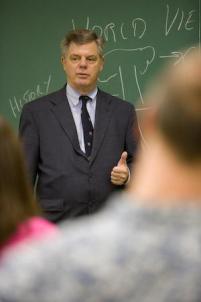'Angels and Demons' Movie Review
May 29, 2009

"Two destinies are predicted of the church by her founder, Jesus Christ. The first is tribulation (Mt. 24:21; Rev. 7:14). For over 2000 years the church has been buffeted about, its people martyred, its teachings maligned, or, worse, ignored. The second is triumph. In Christ, all enemies have been disarmed, put to shame (Col. 2:15). Even though in the world there is trouble, Jesus has overcome the world (John 16:33). However strangely, Angels & Demons, the prequel to The Da Vinci Code, and now a movie, tells both of these stories.
"Opposition to the church appears to come in this case from an obscure group called the Illuminati, bent for centuries on avenging their marginalization by an institution they deem opposed to science and progress. But in the end the true enemy is identified, a son of the church who could never accept its authority. Through a Harvard scholar and a CERN scientist, the Vatican is saved from destruction by an extraordinary bomb, built from anti-matter. Whew!
"I saw the movie, Angels & Demons, just one day after its release. As predicted, it is action-packed, and it was not quite as good as promised, and perhaps not quite as predictable as feared. The first week end, in the U.S., the film grossed a mere $48 million. But world-wide, it totaled over $152 million. For what it’s worth, that is below Star Trek, and not quite in the league with Indiana Jones and the Crystal Skull. What’s the verdict? Depends what you are looking for.
"For me, the novel was better, with Dan Brown’s combination of fast-paced travel log and major conspiracies to undo the Church. Truly angels vs. demons! Still, the visuals were potent, including the death scenes, the branding of illuminati scripts, the mysterious sculptures, the depths of Peter’s tomb, and, above all, the magnificent fireworks explosion of the anti-matter bomb thousands of feet above the city.
"A.O. Scott wrote for the New York Times, 'This movie, without being particularly good, is nonetheless far less hysterical than Da Vinci. ... Mr. Howard's direction combines the visual charm of mass-produced postcards with the mental stimulation of an easy Monday crossword puzzle. It could be worse.' Perhaps a bit cynical. What’s wrong with a nice postcard every now and then? The film was more, actually, since so much of the Roman scenery is likely to remind viewers of their travels, plus make them wonder whether Bernini was something more than just a good sculptor. And it was more, because of the issues it raises.
"Tom Hanks does a predictably solid job as the Harvard symbologist destined to save the Vatican, even though the part is not particularly demanding. The female protagonist, Vittoria, played by Ayelet Zurer, is far less 'cute' than her predecessor, Audrey Tautou, in Da Vinci Code, but somehow more believable. Unfortunately (because it adds a bit of humanity), the romance between them portrayed in the novel was reduced to about nil in the movie. They are just partners. Further, she is never abducted by the evil Hassassin, nor do we sense her affection for her murdered father.
"In fact, a number of other features in the novel were left out of the film. The 'Assassin' of the film is not the sadistic Arab Muslim of the novel, but a kinder, gentler killer, of European extraction, played by Nikolaj Lie Kaas. He actually lets Robert and Vittoria go, because he was not paid to kill them. He warns, though, that the really dangerous enemies are 'men of God.' Indeed, unlike the novel, these men end up uncovering his treachery and putting him to an end. It’s all so politically correct!
"One of the more sympathetic characters in the movie is Cardinal Strauss, played by veteran, Armin Mueller-Stahl. Although he had refused to evacuate the Vatican upon hearing of the bomb threat, ostensibly because everyone is headed for heaven anyway, he later thanks the still skeptical Langdon for saving the church. Avuncular and wise, he recognizes the issues involved and gives some resolution at the end. He’s the priest we all wish we could confide in.
"The sound-track was appropriately a suspenseful, quasi-religious ostinato, using Hans Zimmer’s 'Requiem for a Dream,' and other pieces, as the driving element of auditory continuity.
"One of the most glaring differences between the movie and the novel is the absence of a rather volatile item in the film, that the camerlengo is actually the Pope’s son by artificial insemination. Unless I missed it, that was never mentioned, even though he is revealed as the true culprit, not the extinct illuminati, at the end. I am guessing this might have caused embarrassment to the Catholic Church, so it was left out.
"All in all, the movie is a sanitized version of the book. We don’t sense the colossal culture wars between 'religion' and 'science,' even though they are mentioned. We don’t have the 'angels'of the camerlengo quite as demonized in the end. We don’t have the demons of the obscurantist Cardinals quite as angelic in the end, mostly ineffective. But the church is saved, even by the skeptical Harvard scholar, and so reason is pressed into the service of religion. Would that things were so simple."
William Edgar, Ph.D., professor of apologetics
www.truthaboutangelsanddemons.com







